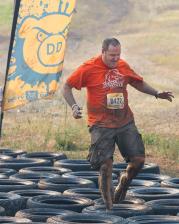What Is Obstacle Racing?
The physical and mental benefits of obstacle racing are huge. In this episode, Get-Fit Guy talks about 3 compelling reasons why you should try an obstacle race.
Ben Greenfield
Listen
What Is Obstacle Racing?
I knew I was in trouble when my muddy hands started slipping off the rope as I dangled 19 feet above an icy cold pit of water. Every muscle in my body twitched and strained in an attempt to keep from falling, but it was too late..

This would be my third penalty in my very first Spartan race experience (my other two burpee penalties coming from narrowly missing a 20-foot spear throw and falling off a sideways traverse wall climb).
But I didn’t care. Even though my lungs were burning, my upper and lower body were spent, my skin was scraped with gravel and punctured with barbed wire, I was caked in dirt, sweat, and blood, nonetheless, I was having the time of my life.
I finished the 30 burpees, clambered over a wall, dove through 4 mud pits, leapt over a pile of burning logs, and fought off 4 weapon-yielding gladiators to finally cross the finish line in a little over an hour and 40 minutes. I’d finished my first “Super Spartan” event.
What Is Obstacle Racing?
In case you hadn’t noticed, obstacle course races and mud runs like the Spartan, Tough Mudder and Warrior Dash are sweeping the nation. From 20,000 participants its 2010 debut year, the Tough Mudder logged nearly 700,000 participants in 2013. With 350,000 participants in 2012, 60+ events in 2013, and over 100 events planned worldwide for 2014, Reebok Spartan Race is one of the fastest growing events in the world.
Obstacle racing is a sport in which, traveling on foot, you must overcome various physical challenges. Obstacles include, but are not limited to, climbing over walls, carrying heavy objects, traversing bodies of water, crawling under barbed wire, and jumping through fire. With a history of heavy military influence, it’s no surprise that many obstacles are similar to those used in military training. But other obstacles are unique to obstacle racing and test endurance, strength, speed, mobility, and mental toughness. Races vary in both distance and challenge level, combining trail running, road running, and cross country running in distances ranging from 1 mile arena sprint events to 26.2+ mile “death races”!
When I finally took the leap earlier this year and completed my first Spartan event, I realized that the physical and mental benefits of obstacle racing are huge. So here are 3 compelling reasons why you may want to try an obstacle race:
Reason #1: Increased Tolerance to Physical Discomfort
I’ve done plenty of triathlons (over 80!), including 5 Ironman World Championships. Triathlon is certainly a tough cardiovascular and musculoskeletal endeavor. So I thought I was in pretty good shape and had a decent pain tolerance until I actually did my first obstacle race.
In my first Spartan I found myself sucking air while crawling on my stomach sandwiched between barbed wire on my backside and gravel under my belly. I felt my back completely lock up and every tiny muscle in my hands cramp as I struggled to carry a 50 pound bucket of gravel up the side of a mountain. And I experienced the icy shock of diving into water that was a good 10-15 degrees colder than any I’d experienced in my 10 years of racing triathlon.
I had the sudden, shocking revelation that even after 5 Ironman World Championship triathlons on the lava fields of Hawaii, and some of the toughest triathlons on the face of the planet in places like Israel, Thailand and Chile, perhaps I wasn’t quite as tough as I thought. And because of that experience – that chance to raise the ceiling of what my body and mind are physically capable of achieving – I guarantee that everything I do in life will feel just a little bit easier (and this includes family challenges, mental challenges, physical challenges, and career obstacles).
Reason #2: Full Body Training Effect
Obstacle course training and racing forces your body to cross-train in dozens of new movement patterns that build cardiovascular and musculoskeletal fitness, and also stress your joints and physiology in a variety of new ways. For example, in a typical obstacle training workout in my backyard in Washington state, I will:
-
Run up a gravel hill, pick up a sandbag, and carry the sandbag around the perimeter of my house.
-
Put down the sandbag, run over to a 30 foot rope, climb up, then descend.
-
Do 20 heavy tire flips.
-
Drag a cinder block attached to a chain 50 yards.
-
Run up a hill to a haybale, grab a homemade spear and throw it into the haybale from 10 yards.
-
Run back down the hill to the house and do 10 pull-ups and 30 burpees.
-
Repeat for 3 rounds.
As you can see, this type of full body workout is far better at building a “bulletproof” body compared to the typical weight training circuit at the gym.
Reason #3: Ability to Conquer the Unknown
In a sport such as triathlon or running races like a 5K or a 10K, you always know the order of each leg of the race – I swim, then I bike, then I run. But in obstacle racing, you might get a quick glance at the map of 20 obstacles just before you set off for the race, with big question marks on the map where surprises might greet you.
In triathlon and running races, you know the exact distances of each leg. But in obstacle racing, you might start a race – a Spartan Sprint for example – knowing that you’ll be running somewhere “around 3 or 4 miles”.
In triathlon or running races, you generally know if we’re going to be on asphalt, concrete or gravel. But in obstacle racing, you don’t know the terrain of the course you’re about to encounter, and you might run on dirt trails, crawl through culverts, run through rocky river beds, scramble over sand dunes, or trudge through waist deep water.
In triathlon or running races, you can preview the course ahead of time. But in obstacle racing, you have no clue where you’re going until the starting smoke grenade is thrown.
Often, we exercise enthusiasts are notorious for being creatures of habit, and rigid in our training. But by doing an obstacle race, you’ll throw a curveball at your brain and your body, and learn valuable life lessons about how to physically and mentally deal with the uncertainty.

And I must admit, that feeling of danger and the unknown is actually quite exhilarating – so much so that I am now recommending to everyone I know that they need to do at least one obstacle race. So what are you waiting for? Go find a Tough Guy, Spartan Race, Tough Mudder, Atlas Race, Warrior Dash, Superhero Scramble, or any other variation of an obstacle race or mud run and experience life to the fullest!
If you have more questions about obstacle racing, then leave your thoughts and join the discussion over at Facebook GetFitGuy.
Woman in obstacle race and man in obstacle race images courtesy of Shutterstock.

 Run up a gravel hill, pick up a sandbag, and carry the sandbag around the perimeter of my house.
Run up a gravel hill, pick up a sandbag, and carry the sandbag around the perimeter of my house.
